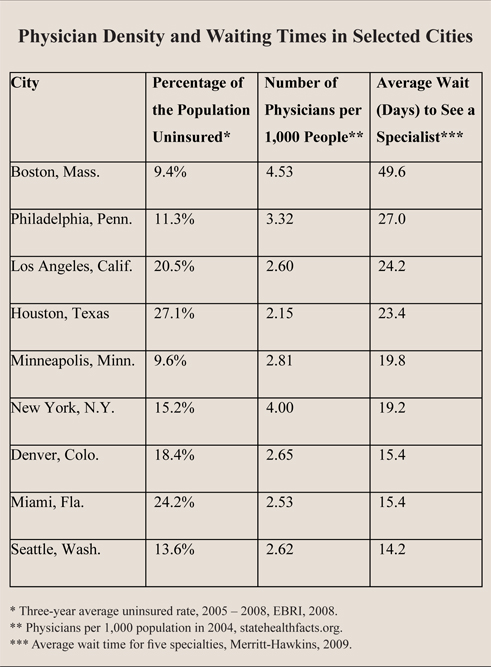The Massachusetts experiment in health care reform offers many lessons that are applicable to the current debate in Congress. The goals of the Massachusetts plan are similar to proposals supported by Democratic congressional leaders and the Obama administration: universal health insurance coverage through greater access to health insurance.
The Obama proposals would use similar means to achieve these goals: requiring individuals to purchase insurance and creating an "insurance exchange" where they can buy heavily regulated, heavily subsidized health insurance.
Some of the lessons to be learned from the Massachusetts experience have been well-chronicled elsewhere, but there are three lessons that remain to be explored.
Lesson 1: Reform has raised costs, not lowered them. The state has indeed lowered the number of uninsured dramatically – down to 2.6 percent of the population by some estimates. But it has done so in a very expensive way that does nothing to control costs. Massachusetts has relied primarily on two factors to fund its plan: 1) state premium subsidies for almost everyone who has gained coverage and 2) the requirement that individuals enroll. This is a huge burden on taxpayers and on anyone who pays directly for health care:
- The state was able to get the federal government to pay for much of these new costs, but even with that help, state government spending has increased 42 percent since 2006.
- The Massachusetts program has cost about one-third more than projected when the law was passed.
- Before the Massachusetts health insurance reform plan was implemented in 2005, total per capita health care spending in the state was 33 percent above the national average.
- In just two years under the Massachusetts reforms, from 2005 to 2007, health care spending per capita rose an additional 23 percent.
Lesson 2: The people reform was intended to help say they are being hurt. That level of spending might be justified if it was clear that large numbers of previously uninsured people were being helped. But a survey conducted by the Harvard School of Public Health found just the opposite.
- Slightly more than half (51 percent) of those required to purchase coverage say their health care costs have gone up and only 14 percent say they have gone down.
- Some 22 percent say the law is helping them personally, but 60 percent say it is hurting them.
Although the survey found that most residents of Massachusetts support the law, the level of support is greatest among those least affected – the people who are more likely to have insurance or be able to afford coverage because of their education and income:
- Some 69 percent of those with college degrees or incomes of more than $75,000 a year support the law.
- Just 49 percent of those making $25,000 to $50,000 and only 45 percent of those with a high school or lower education, support it.
Lesson 3: Everyone else is being hurt, too. It isn't only those directly affected by the mandate who are being hurt in Massachusetts. Due to the sudden increase in demand for physicians, every resident who would like to see a doctor is being harmed. Massachusetts has by far the largest number of physicians per capita of any state. Despite this, patients in Massachusetts now have the longest waiting times to see a doctor, according to a recent survey of physician waiting times in 15 major U.S. cities. For example, in Boston the average waiting time to get an appointment for any of five types of specialists is almost double the wait in the next highest area, Philadelphia. [See the table.]
Long waiting times to see a physician have caused the use of hospital emergency rooms to soar by 17 percent to 2.5 million visits in 2007. Half of these ER visits were for nonurgent conditions. Although one of the state's goals was to increase access to private physicians for the previously uninsured, Massachusetts payments to community health centers for free care to the indigent have increased from $52.2 million in 2005 to $58.6 million in 2007.
Lessons for America. Of all these developments, the most sobering one is the soaring waiting times to see a doctor. Previously, Massachusetts enjoyed the highest number of physicians per capita of any state, and it had one of the lowest rates of noninsured in the country. If any jurisdiction could have accommodated a surge of newly insured people it should have been Massachusetts. By contrast, California has half as many physicians per capita and twice the level of uninsured. Imagine what will happen to waiting times in California if all the uninsured suddenly become insured. As in Massachusetts, if they can't see a doctor on a timely basis, patients may seek treatment at hospital emergency rooms. But California doesn't have any excess capacity there, either. Waiting times in ERs will soar. Other big states like Texas and Florida are even less able than California to serve the newly insured.
What kind of health care reform requires working people to pay for coverage, but then deprives them of the ability to see a doctor? It is the kind that will generate an enormous backlash of outraged patients. Members of Congress need to think twice before embarking on the same journey as Massachusetts.
Greg Scandlen is director of Consumers for Health Care Choices at the Heartland Institute.